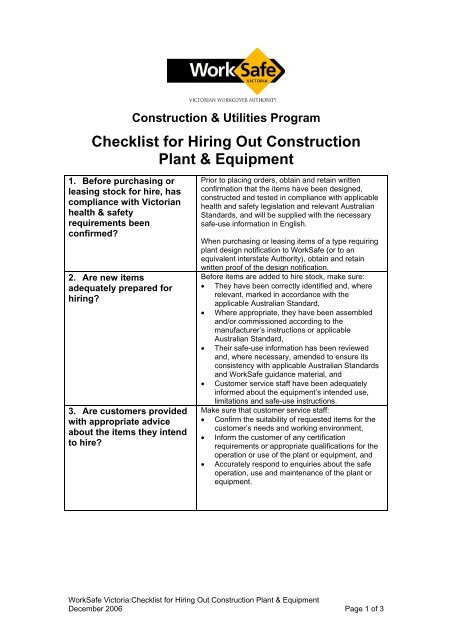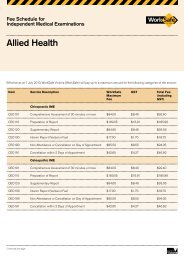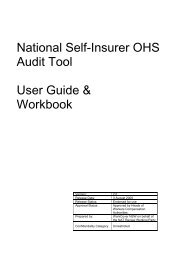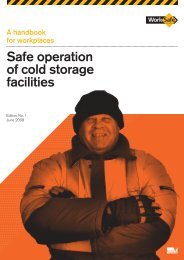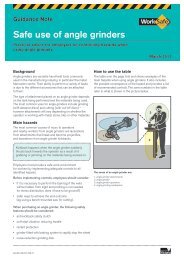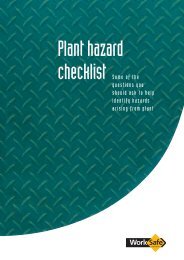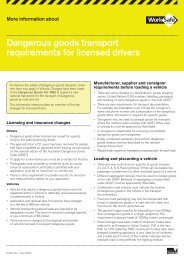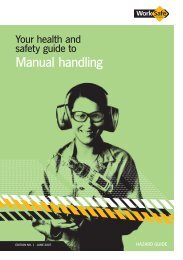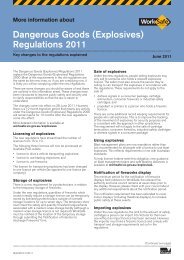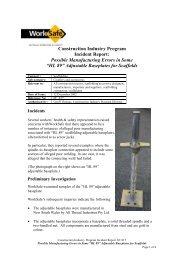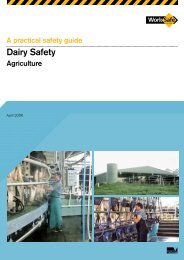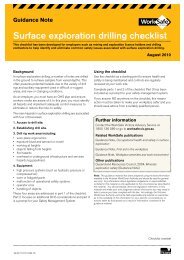Checklist for Hiring Out Construction Plant ... - WorkSafe Victoria
Checklist for Hiring Out Construction Plant ... - WorkSafe Victoria
Checklist for Hiring Out Construction Plant ... - WorkSafe Victoria
Create successful ePaper yourself
Turn your PDF publications into a flip-book with our unique Google optimized e-Paper software.
<strong>Construction</strong> & Utilities Program<br />
<strong>Checklist</strong> <strong>for</strong> <strong>Hiring</strong> <strong>Out</strong> <strong>Construction</strong><br />
<strong>Plant</strong> & Equipment<br />
1. Be<strong>for</strong>e purchasing or<br />
leasing stock <strong>for</strong> hire, has<br />
compliance with <strong>Victoria</strong>n<br />
health & safety<br />
requirements been<br />
confirmed?<br />
2. Are new items<br />
adequately prepared <strong>for</strong><br />
hiring?<br />
3. Are customers provided<br />
with appropriate advice<br />
about the items they intend<br />
to hire?<br />
Prior to placing orders, obtain and retain written<br />
confirmation that the items have been designed,<br />
constructed and tested in compliance with applicable<br />
health and safety legislation and relevant Australian<br />
Standards, and will be supplied with the necessary<br />
safe-use in<strong>for</strong>mation in English.<br />
When purchasing or leasing items of a type requiring<br />
plant design notification to <strong>WorkSafe</strong> (or to an<br />
equivalent interstate Authority), obtain and retain<br />
written proof of the design notification.<br />
Be<strong>for</strong>e items are added to hire stock, make sure:<br />
• They have been correctly identified and, where<br />
relevant, marked in accordance with the<br />
applicable Australian Standard,<br />
• Where appropriate, they have been assembled<br />
and/or commissioned according to the<br />
manufacturer’s instructions or applicable<br />
Australian Standard,<br />
• Their safe-use in<strong>for</strong>mation has been reviewed<br />
and, where necessary, amended to ensure its<br />
consistency with applicable Australian Standards<br />
and <strong>WorkSafe</strong> guidance material, and<br />
• Customer service staff have been adequately<br />
in<strong>for</strong>med about the equipment’s intended use,<br />
limitations and safe-use instructions.<br />
Make sure that customer service staff:<br />
• Confirm the suitability of requested items <strong>for</strong> the<br />
customer’s needs and working environment,<br />
• In<strong>for</strong>m the customer of any certification<br />
requirements or appropriate qualifications <strong>for</strong> the<br />
operation or use of the plant or equipment, and<br />
• Accurately respond to enquiries about the safe<br />
operation, use and maintenance of the plant or<br />
equipment.<br />
<strong>WorkSafe</strong> <strong>Victoria</strong>:<strong>Checklist</strong> <strong>for</strong> <strong>Hiring</strong> <strong>Out</strong> <strong>Construction</strong> <strong>Plant</strong> & Equipment<br />
December 2006 Page 1 of 3
4. Is adequate written safeuse<br />
in<strong>for</strong>mation provided to<br />
customers?<br />
5. Is safe-use in<strong>for</strong>mation<br />
kept up to date?<br />
6. Are safety design faults<br />
appropriately dealt with?<br />
7. Are items adequately<br />
inspected and maintained<br />
between each hiring and at<br />
appropriate frequencies?<br />
Provide written safe-use in<strong>for</strong>mation <strong>for</strong> each specific<br />
make and model of plant and equipment hired to the<br />
customer. This includes, as appropriate:<br />
• Data sheets, brochures and/or users’ checklists,<br />
• Erection or assembly instructions,<br />
• Description of skills or qualifications required <strong>for</strong><br />
operation or use, including certificates of<br />
competency, specialist training or other<br />
qualifications,<br />
• Operators’ manuals,<br />
• Description of personal protective equipment<br />
necessary <strong>for</strong> its safe use or operation , and<br />
• Any other health or safety in<strong>for</strong>mation you have<br />
that is relevant to the particular item.<br />
Safe-use in<strong>for</strong>mation should be accurate and up-todate.<br />
Remove obsolete or superseded in<strong>for</strong>mation from<br />
stock normally accessed by customer service staff.<br />
On becoming aware of new or revised safe-use<br />
in<strong>for</strong>mation or product recalls, promptly notify<br />
customers who have hired affected items, and<br />
maintain records of such notifications.<br />
When staff, servicing contractors or customers advise<br />
you of a potential safety design fault in a particular<br />
item, promptly notify the designer, manufacturer,<br />
importer or supplier wherever possible, and seek<br />
advice on how to deal with the issue. Where none of<br />
these is contactable, engage a suitably expert person<br />
to advise you on the issue and what needs to be<br />
done.<br />
Between-hiring inspection and maintenance is<br />
necessary to ensure that re-hired items are provided<br />
in a serviceable condition, and that unserviceable or<br />
obsolete items are removed from hire stock.<br />
Where items are to be hired out <strong>for</strong> an extended<br />
period, make arrangements with the customer <strong>for</strong><br />
inspection and maintenance at the intervals<br />
recommended by the manufacturer or the applicable<br />
Australian Standard.<br />
Inspections and maintenance may be conducted onsite<br />
where conditions are appropriate and the<br />
necessary equipment is available.<br />
Make sure that inspection, testing and servicing staff<br />
or contractors are suitably instructed, trained and,<br />
where appropriate, qualified.<br />
Make sure that inspection and maintenance records<br />
are kept and are readily accessible.<br />
<strong>WorkSafe</strong> <strong>Victoria</strong>:<strong>Checklist</strong> <strong>for</strong> <strong>Hiring</strong> <strong>Out</strong> <strong>Construction</strong> <strong>Plant</strong> & Equipment<br />
December 2006 Page 2 of 3
8. Are unserviceable or<br />
obsolete items adequately<br />
segregated and correctly<br />
disposed of?<br />
9. Are items hired <strong>for</strong> use<br />
interstate in compliance<br />
with local health and safety<br />
requirements?<br />
Do not re-hire items which have not been inspected<br />
since returning to the hire depot.<br />
Segregate items due <strong>for</strong> inspection or maintenance<br />
and unserviceable items from ready-to-hire stock.<br />
Dispose of items no longer in hire stock by:<br />
• Selling or otherwise providing them in a safe and<br />
serviceable condition, together with their safe-use<br />
in<strong>for</strong>mation and maintenance records, or<br />
• Disposing of them as scrap, together with clear<br />
written advice to that effect.<br />
When supplying items to interstate customers, make<br />
sure you have complied with the local health and<br />
safety requirements <strong>for</strong> the importation and supply of<br />
plant and equipment.<br />
In most cases, this will be the same as in <strong>Victoria</strong>, but<br />
where there is any uncertainty, obtain a copy of<br />
current local OHS requirements. If you have difficulty<br />
in doing this, seek advice from the relevant State or<br />
Territory workplace health and safety authority.<br />
ADDITIONAL INFORMATION ABOUT YOUR OBLIGATIONS AS A SUPPLIER<br />
Section 30 of the <strong>Victoria</strong>n Occupational Health and Safety Act 2004 requires<br />
suppliers to ensure that items of plant intended <strong>for</strong> use at a workplace:<br />
• Have been designed and constructed to be, so far as is practicable, safe and<br />
without risks to health when properly used,<br />
• Have been sufficiently tested and examined to ensure that this is so, and<br />
• Are accompanied with adequate in<strong>for</strong>mation about their intended purpose and<br />
any conditions necessary to ensure their safe use.<br />
In the case of certain types of equipment intended to be used in non-workplaces,<br />
such as the home handyman market or <strong>for</strong> volunteer organisations, Section 8 of the<br />
<strong>Victoria</strong>n Equipment (Public Safety) Act 1994 also requires suppliers to ensure the<br />
above. The equipment types to which this Act applies are listed in Regulation 105 of<br />
the Equipment (Public Safety) (General) Regulations 1995.<br />
Regulations made under these Acts also place specific obligations on suppliers of<br />
plant and equipment. These include:<br />
• The Occupational Health and Safety (<strong>Plant</strong>) Regulations 1995,<br />
• The Occupational Health and Safety (Noise) Regulations 1992,<br />
• The Occupational Health and Safety (Manual Handling) Regulations 1999,<br />
and<br />
• The Equipment (Public Safety) (General) Regulations 1995.<br />
Requirements <strong>for</strong> certificates of competency are set out in the Occupational Health<br />
and Safety (Certification of <strong>Plant</strong> Users and Operators) Regulations 1994.<br />
The above legislation can be accessed through the <strong>Victoria</strong>n Law Today web page<br />
at:<br />
www.dms.dpc.vic.gov.au<br />
<strong>WorkSafe</strong> <strong>Victoria</strong>:<strong>Checklist</strong> <strong>for</strong> <strong>Hiring</strong> <strong>Out</strong> <strong>Construction</strong> <strong>Plant</strong> & Equipment<br />
December 2006 Page 3 of 3


